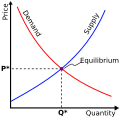Creator economy
The creator economy or also known as creator marketing and influencer economy, is a software-driven economy that is built around creators who produce and distribute content, products, or services directly to their audience, leveraging social media platforms and AI tools.[1] These creators - who may include social media influencers, YouTubers, bloggers, artists, podcasters, and even independent professionals - generate revenue from their creations through a variety of monetization strategies, including advertising, sponsorships, product sales, crowdfunding, and subscription-based services.[2] According to Goldman Sachs Research, the ongoing growth of the creator economy will likely benefit companies that possess a combination of factors, including a large global user base, access to substantial capital, robust AI-powered recommendation engines, versatile monetization tools, comprehensive data analytics, and integrated e-commerce options.[3] Examples of creator economy software platforms include YouTube, TikTok, Instagram, Facebook, Twitch, Spotify, Substack, OnlyFans and Patreon.[4][5][6][7][8] HistoryIn 1997, Stanford University's Paul Saffo suggested that the creator economy first came into being in 1997 as the "new economy". Early creators in that economy worked with animations and illustrations, but at the time there was no available marketplace infrastructure to enable them to generate revenue.[citation needed] The term "creator" was coined by YouTube in 2011 to be used instead of "YouTube star", an expression that at the time could only apply to famous individuals on the platform. The term has since become omnipresent and is used to describe anyone creating any form of online content.[9] A number of platforms such as TikTok, Snapchat, YouTube, and Facebook have set up funds with which to pay creators.[10][11][12][13][14] CriticismThe large majority of content creators derive no monetary gain for their creations, with most of the benefits accruing to the platforms who can make significant revenues from their uploads.[15] As few as 0.1% of creators are able to earn a living through their channels.[16] See also
References
|
Portal di Ensiklopedia Dunia














